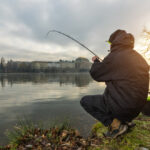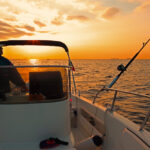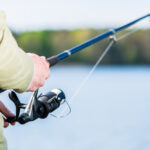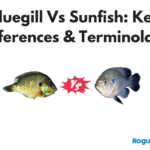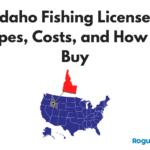Salmon is one of the most popular freshwater fish due to its delicious flavor, nutritional value, and excellent fight. Fishermen have utilized the migratory habits to optimize their success when fishing for salmon. If you’re wondering how to fish for salmon, this in depth guide will give you the best opportunity to catch this fun, tasty fish.
We’ll discuss a range of topics including how to fish for salmon from shore, how to fish for salmon from rivers, how to drift fish for salmon and others. We’ll also discuss the best salmon fishing techniques, salmon bait, the best rods for salmon fishing, the best reels for salmon fishing, and much more! Read on to learn everything you need to know about how to fish for salmon in 2023!
Part 1: How to Fish for Salmon: Salmon Fishing Techniques
I guess the very first step is to determine where you’ll be fishing, as that will dictate which technique you choose. Freshwater salmon fishing can be done from the shore or from your boat. Many of the methods can be used in either circumstance, but if fishing by foot, aka no boat, you’ll be slightly more restricted.
Technique 1: Trolling
Trolling consists of fishing out of a moving boat. Trolling fishermen will use weights, divers, or downriggers to achieve an acceptable depth to present their bait or lures to the salmon. Freshwater trolling for salmon is often done in the lower ends of larger rivers. This is because the incoming tide tends to cause river flows to slow down.
Trolling Gear
Many of the same drift fishing equipment standards can be used for trolling. Where trolling setups differ are through the use of a three-way swivel at the end of the mainline, a 12-36” dropper line with weight, and a 4-8’ foot leader with your hook. Cut bait works well here as well. Again like drift fishing, spinners and kwikfish are good options too.
Weights are usually 2-8 ounces depending on the speed of the current and boat. The faster everything is moving, the heavier you’ll need to go. A good trick is to keep your dropper line lighter than your main line. This allows the dropper line to break before your main line in case you snag up.
When fishing for spring chinook, try to stay near the bottom, bouncing your weight often. Fish at the depth your fish finder shows fish for fall Chinook and coho. Bottom is always a good bet for Chinook. For coho, you may not even need weight
Technique 2: Drift Fishing
If you’re wondering how to drift fish for salmon, here you go! Drift fishing is a common method where the fisherman casts a line upstream, lets the line drift back downstream and then reels in the line to start the cycle again. You can drift fish from shore or from an anchored boat. Typically, you want to weight your setup so it bounces along the bottom, touching about every foot at roughly the same speed as the current. The more weight you add, the slower your bait will drift. The ideal strategy is to start your cast near upstream riffle and let it float all the way to the downstream riffle. This can be more of a challenge when you’re fishing in a crowded area.
An important skill for novices to learn is deciphering between a bite and a snag. As your bait bounces along the bottom, it may snag on debris. It’s important to learn the difference between a bite, so you can set the hook, versus a snag, in which case you need to finesse your lure free. This technique is one of the best ways to catch salmon from the river.
Drift Fishing Gear
Drift fishing gear typically includes an 8′ 1/2 to 9′ rod equipped for 15-30 pound line. You’ll alsso need either a bait casting reel or a spinning reel.
For larger fish, like Chinook salmon, operate at the higher end of the spectrum – 20-30lb. For smaller salmon, stay around 10-15 pound test. When it comes to baits, there are a huge variety of weights, lures, and floats, that you can can use. A standard setup for salmon consists of a snap swivel at the end of the mainline, a leader ranging from 12-48” with a single hook.
One of the most successful types of live bait for salmon fishing is to use roe. Many fishermen are also now switching to cut bait of herring or a smelt. There is also the option of using a “spoon” which is a thin, artificial lure that mimics the movement of fish. You can also have success with spinners. There’s really an endless combination!
Technique 3: Plunking
Plunking is slightly different than drift fishing in that your bait is cast into a “fishy” area and left there. The gear is left alone until a fish strikes or you decide to change gear. When plunking, active lures like winged bobbers, spoons, or spinners are often the most successful. Plunking is versatile strategy that can be done from shore or an anchored boat.
One of the most important aspects of plunking is where to set the gear. On larger rivers, try to set up on an inside curve where fish migrating up that side are forced around the bend. In smaller rivers, you can look for tail outs just upstream of riffles. These are both areas that salmon use to rest after swimming through the riffles. Salmon are looking for the eassiest route up the river that still has some protection. Keep an eye out for areas where the current tends to slack up. Also look for cover like deeper water, logs, boulders, a bubble curtain, or possibly the white water in a riffle.
Plunking Gear
For plunking, you’ll want to go a bit more heavy duty. Try an 8′ 1/2 to 9′ rod with a lot of backbone. Your mainline should be 40-60 pound, usually monofilament. At the end of your mainline, slip your line through the end of a swivel or slider, add 4-6 beads, and then tie to a swivel. From here, tie 4-6 foot of 40-60 pound monofilament leader to the other end of the swivel and then directly to your bait. Tie another 18-30” piece of 15 pound leader to the slider (or swivel that you ran the mainline through) and attach 1-8 ounces of lead. Cmmon sizes for salmon are K13 to K16.
Technique 4: Bobber/Float Fishing
Our final technique is Bobber or float fishing. This is great If you’re wondering how to fish for salmon from shore. This is typically used in situations where water is very slow moving or even stationary, such as slack tide. Longer rods of 10-12’ are not uncommon for float fishing.
The key here is to set your float at the depth where the fish are lingering. This can be easaier said than done, but here are some general guidelines. When the sun hits the water, salmon tend to move to the bottom. At this time, you’ll want to set your float pretty deep, about a foot from the bottom.
When float fishing in current, you will need to lifting or flip the line periodically so that any belly is removed. This helps keep the line in a straight line between the rod and bobber. You can also increase your success rate by using a line with less stretch. This helps create better hook sets.
Float Fishing Gear
Use a sliding float, a swivel, weight to pull the line through the float, and a 12-24” leader to a bait or lure. A “bobber stop” and small bead are used to set your float. This keeps your bait at the depth you wish to fish. The bobber stop can be reeled through the rod guides if necessary for convenience.
Salmon eggs (roe) are again one of the top choices for bait.
Part 2: How to Fish for Salmon: Best Lures and Best Bait for Salmon
Alright, so you’re ready to go with your salmon fishing techniques. Now the question is, what is the best bait for salmon fishing? Well, as we’ve touched on already, there are quite a few options. Let’s learn more about each one.
Spinners
Spinners have metal blades that spin as the lure moves through the water. As the light hits this spinning motion, it causes a reflection, similar to the scales of a real fish!
Spinners have four basic designs:
- Standard inline: This is where the blades of the spinner revolve around a straight wire
- Spinnerbaits: These come with lead molded to the lower arm and the spinning functionality attached to an upper arm
- Buzzbaits: These tend to raise towards the surface, so these are not recommended for salmon fishing
- Live bait spinners: These utilize the spinner in front of live or cut bait
Bobbers
Bobbers are used to keep your bait off the bottom. There are a huge variety of bobbers you can use
Kwikfish Lures
Kwikfish is a popular brand of lure used by many salmon fishermen today. They’re often wrapped with other bait such as sardines.
Cut / Live Bait
There’s a good variety of cut and live bait you can use. Some of the most popular are sardines, herring, smelt and eggs. Eggs are often considered the overall best bait for salmon.
Other successful baits are sand shrimp and minnows. Minnows are a very common bait for any fredsshwater fish, and a lively minnow can be a great choice. Some fishermen consider sand shrimp one of the best baits as well, however, they’re often disregarded because they’re more expensive and difficult to rig.
Part 3 – How to Catch Salmon: Best Salmon Fishing Gear
Having the right gear for any fishing trip can make or break the entire day. We’ve discussed the salmon fishing techniques and the best lures and bait for salmon fishing. Now it’s time to discuss what gear you’ll need to have the most successful salmon fishing trip.
Proper Credentials
a basic one, but important one. Don’t forget to have the proper licensing for your trip. If fishing out of state, always be sure to double check the laws and regulations of wherever you’re going.
Reels
There are a few different types of salmon reels depending on which type of fishing you’ll be doing.
- Spinning Reels: Spinning reels are used predominantly when casting on rivers especially if you are using lighter bait rigs and smaller lures.
- Trolling Reels: Trolling reels for salmon need to be heavier duty. They should be capable of storing a lot of line for a good fight, have a high drag rating and be well sealed.
- Casting Reels: Casting reels require some additional practice, but they are excellent for things like river fishing. If you’re going to be casting a lot, once mastered, they are much easier than a spinning reel.
Rods
Most rods can be used for a variety of fishing techinques. When it comes to selecting a salmon fishing rod, here’s a few things to consider:
- Rod type: Spinning, trolling or casting. Which do you plan on doing? Buy accordingly.
- Rod length: Typical rod lengths for salmon range from 9′ to 12′. There always exceptions. Review the fishing techniques above to determine the best length for your style of fishing.
- Rod power: Typically trolling will require the most power. The bigger the fish, the sturdier the rod will need to be.
- Rod action: The faster the action, the more sensitive the rod is. Faster rods are great when you need to strike quickly, typically with lighter rigs.
Hooks
No particular type of hook is necessarily needed. The traditional salmon or steelhead hook is a strong, short shank, eye-up hook. The hook size depends on the river conditions and the type of bait used. A size 4 should be big enough for almost any sized salmon. A size 10 or 12 will get more strikes in clear conditions, but landing the fish is very difficult. Typically, you’ll see more hookups with small sized hooks (10+), but less fish landed.
Fishing Line and Leader
The right salmon fishing line will often be determined by the type of salmon you are targeting.
- Monofilament: Still one of the most popular fishing lines available today. You can never go wrong with mono for the price. Review the techniques above for specific line strength recommendations.
- Fluorocarbon: Fluoro is an excellent option for drift fishing. It reflects the light in the water much better than mono making it very difficult for salmon to see. It is more expensive so using it for leader is also a good option.
- Super line: Super lines and specialty lines are made up of different materials and combinations of materials than standard lines. Super lines are designed for strength. They are made through braiding the strands of material and are popular for extra strength and lack of stretch (about 5% opposed to monofilament which is about 20%).
Fishing Waders
Waders come in a variety of materials, sizes and styles. The price varies widely and you can find a set suited to the type of fishing, climate, season and waters you’ll be fishing. With that in mind, here are a few things to consider when purchasing your next set of waders. Be sure to consider the wader material and insulation. Warm weather fishing will definitely require a different wader than colder weather. Breathability matters.
Conclusion – Hopefully You Know How to Fish for Salmon Now!
While there’s no teaacher like experience, hopefully you know more about fishing for salmon than you did before you read this guide. We’ve covered a lot – from salmon fishing techniques, to the best salmon bait and lures, to all your other salmon fishing equipment. Take this information, prepare yourself for your next trip and get out there!
Hopefully you enjoted this guide about how to catch salmon. Go catch ’em up!
